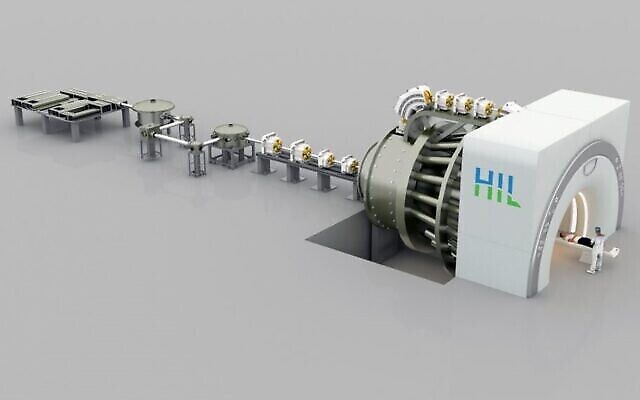Israeli breakthrough to cut cancer treatment cost
HIL Applied Medical hopes to make life-saving proton-beam radiotherapy affordable and accessible

AN Israeli startup has found a way to slash the cost of an advanced treatment for some forms of cancer, potentially saving millions of lives.
Technology developed by HIL Applied Medical, based on a breakthrough by scientists at Hebrew University, is set to deliver proton-beam radiotherapy to millions of cancer patients who cannot access it today because the machines are too big and too expensive.
Proton radiotherapy, used to treat solid tumours, causes less damage to surrounding healthy tissue than traditional X-ray or photon radiation therapy, improving patient survival and quality of life. It is used routinely to treat many types of cancer, is cleared by the FDA, and is reimbursed by both public and private insurers around the world.
It is “so much better for the patient. It makes tumours go away and stay away with far fewer side effects,” says Prof. Zelig Tochner, former head of the Radiation Oncology Department at Hadassah University Medical Center in Jerusalem, and first medical director of the Roberts Proton Therapy Center at the University of Pennsylvania.
While recent advances have reduced the scale of a proton radiotherapy facility from the size of a football field to a tennis court, and the cost from US$30-200 million, the price tag is still too high for most hospitals. There are only 238 proton therapy treatment rooms worldwide – compared with 13,000 regular radiotherapy rooms.
“The massive size and cost of a single facility, each of which can see only 25 to 35 patients a day, created a huge barrier,” says Tochner, who is now an adviser to HIL. The result is that just five percent of some two million cancer patients each year can receive the better treatment.
Until now.
HIL’s technology cuts the massive size and cost of proton radiotherapy equipment to a single treatment room that can fit into a standard 500 sq. ft. radiotherapy unit for just $15 million. The reduced expense means it can pay for itself much quicker, bringing it within reach of hospitals and clinics.
Tochner estimates the system will be available to treat patients within five years. “Only HIL is succeeding in making it a real option for millions of cancer patients worldwide,” he says.
“The world needs 4,000 to 5,000 proton therapy rooms,” says Sagi Brink-Danan, HIL’s CEO, adding that HIL plans eventually to produce 200-250 such systems per year.
“It’s a huge potential market,” Brink-Danan says. “If even half of the two million cancer patients in the world each year get proton treatment – a conservative estimate as we make the technology affordable – with existing reimbursement averaging $40,000 per patient, that’s a $40 billion per annum market right there.”
HIL’s technology is based on its patented approach to particle acceleration and beam delivery. Using a breakthrough achieved by the Hebrew University’s high-energy physics lab, it combines nanotechnology with ultra-high-intensity lasers and advanced magnetics, enabling HIL to reduce the size, complexity and cost of proton therapy systems without compromising clinical utility. The Hebrew University work was inspired by research into creating ultrashort high-intensity laser pulses that won Gérard Mourou of France and Canadian Donna Strickland the 2018 Nobel Prize in Physics.
The combination of processes and technologies is now protected by over 60 patents. “That’s what allows us to do what no one else can,” Brink-Danan says. “It’s the first real update to technology dating back to the 1930s and 1940s. People from all over the world have relocated to Israel to work with us.”
FDA clearance
The average cost – about $40,000 for each patient – is covered for many by medical insurance. The fact that it already has FDA clearance is a “shortcut that will save years in time to market and millions in costs,” Brink-Danan says. “We have the right product at the right price point, and since we’ve got it patented, anyone who wants to do the same will now need to come talk to us.”
HIL’s first two facilities will be in the US through a partnership with Proton International, based in Georgia, which already has eight proton therapy facilities in the US and is now in the process of committing to add two therapy rooms based on HIL technology by the end of this year. HIL’s first planned facility in Israel is under negotiation with two medical centres. A national proton therapy centre planned for Ichilov hospital in Tel Aviv was delayed by the COVID pandemic.
In January, HIL became the first Israeli startup ever to receive multimillion-dollar development grants from the Israel-US Binational Industrial R&D (BIRD) Foundation, all three divisions of the European Union’s Horizon 2020 program, and the Israel Innovation Authority.
“HIL was certainly one of the most innovative projects submitted this cycle,” says BIRD Foundation executive director Eitan Yudilevich. “We think it has a great chance of success because of its breakthrough capabilities, paired with the high quality of its US partnership and its ability to bring proof-of-concept to the many people needing this cancer treatment. It’s high risk, but with high risk comes high return.”
HIL Applied Medical is raising an investment round on the OurCrowd platform. For more information, click HERE.
Times of Israel
Promoted content

comments